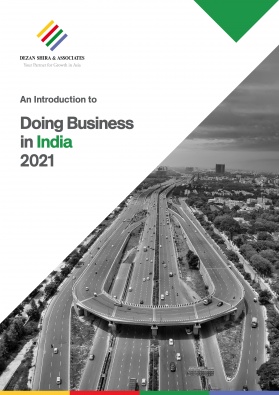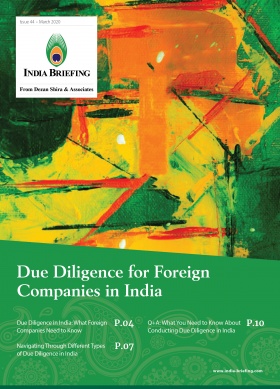India’s Connectivity Infrastructure: Status of Keystone Projects
We take a look at India’s connectivity infrastructure, including the status of proposed projects and how they link to an overall vision for the country’s logistics sector and economic development.
One of the crucial components that drive and sustain economic growth in a country is its infrastructure, which is critical for achieving manufacturing competitiveness.
Key challenges obstructing progress in India’s infrastructure sector are its complicated land acquisition policies, implementation delays, and the risk of project overruns due to bureaucratic quagmire. To address these, the Central Government has implemented policies to minimize delays, simplify compliance procedures, and improve transparency.
Policies to increase the pace of infrastructure projects include simplification of land acquisitions, faster clearance/approvals from relevant authorities, using technologies, such as On-line Computerized Monitoring System (OCMS) and Pro Active Governance and Timely Implementation (PRAGATI) to improve project monitoring, and creating cost committees at the federal level to monitor cost overruns.
Infrastructure spending and development are key focus areas of the Union Budget 2022-23. For more details, read our article here: India’s Union Budget 2022-23: Key Highlights
Industrial and freight corridor projects
The government launched the National Infrastructure Pipeline (NIP) for FY 2019-25, under which projects have been identified to construct, refurbish, strengthen, and expand roads networks, housing, urban development, railways, conventional power, renewable energy, and irrigation. Key programs will focus on highways and railways.
The Industrial Corridor Projects, part of the National Industrial Corridor program, is an example, and aligns with the development of industrial cities and improving inter-city connectivity so that they can compete with top global investment
destinations.
In addition, the government has also established a Special Purpose Vehicle for construction, operation, and maintenance of dedicated freight corridors under the Dedicated Freight Corridor (DFC) program that aims to decongest the existing rail network by constructing dedicated tracks for goods trains. Currently, the construction work for both projects is in full swing.
Sagarmala Program for port development
For port infrastructure, since its launch, the Sagarmala Program (2015-2035) has identified more than 574 projects worth INR 6.01 trillion across areas of port modernization and new port development, port connectivity enhancement, port-linked industrialization, and coastal community development.
As of September 30, 2019, a total of 121 projects at a cost of INR 302.28 billion have been completed and 201 projects at a cost of INR 3.09 trillion are under implementation. The states of Gujarat, Maharashtra, Karnataka, Andhra Pradesh, and Tamil Nadu, among the top investment destinations in India, account for the country’s ports and sea routes.
Development along main transportation corridors
India’s federal government has approved infrastructure proposals worth INR 77.25 billion (approx. US$1.06 billion) to set up greenfield industrial cities with connectivity to major transportation corridors, such as the eastern and western dedicated freight corridors, expressways, national highways, ports, and airports.
This aligns with India’s focus on developing industrial hubs across the country to effectively participate in the global supply chains (see map below for industrial hubs expected to benefit from the Production-Linked Incentive schemes).
The industrial corridors will integrate industries with necessary infrastructure, create employment opportunities, as well as boost export avenues by ensuring smooth access to production units, decreased transportation and communications costs, improved delivery times, and reduction in inventory costs.
Mapping India’s infrastructure connectivity
 Status of India’s industrial corridor projects
Status of India’s industrial corridor projects
|
No. |
Corridor |
No. of projects |
Name |
Status |
|
1 |
DMIC: Delhi Mumbai Industrial Corridor |
10 |
|
Under implementation |
|
Project has been approved on 30/12/2020 |
|||
|
Project development activities underway |
|||
|
2 |
CBIC: Chennai Bengaluru Industrial Corridor |
3 |
|
Projects approved on 30/12/2020 |
|
Project development activities underway |
|||
|
3 |
Extension of CBIC to Kochi via Coimbatore |
2 |
|
|
|
4 |
AKIC: Amritsar Kolkata Industrial Corridor |
7 |
|
|
|
Project development activities have not initiated yet |
|||
|
5 |
HNIC: Hyderabad Nagpur Industrial Corridor |
1 |
|
Project development activities underway
|
|
6 |
HWIC: Hyderabad Warangal Industrial Corridor |
1 |
|
|
|
7 |
HBIC: Hyderabad Bengaluru Industrial Corridor |
1 |
|
|
|
8 |
BMIC: Bengaluru Mumbai Industrial Corridor |
2 |
|
|
|
||||
|
9 |
VCIC: Vizag Chennai Industrial Corridor |
3 |
|
Project development activities underway |
|
10 |
OEC: Odisha Economic Corridor |
1 |
|
|
|
11 |
DNIC: Delhi Nagpur Industrial Corridor |
1 |
|
|
Source: Ministry of Commerce and Industry, dated August 4, 2021
Status of Chennai-Bengaluru (CBIC), Bengaluru-Mumbai (BMIC), and Hyderabad-Bengaluru (HBIC) corridors
In terms of their cascading effect – the industrial corridors will facilitate setting up industrial townships, educational institutions, and hospitals, and in the process raise the standards of human development. In many regions, this would check the pace of outmigration and promote talent retention in lower tier cities.
Chennai Bengaluru Industrial Corridor (CBIC)
The three nodes being developed under this corridor are Krishnapatnam in Andhra Pradesh, Tumakuru in Karnataka, and Ponneri in Tamil Nadu. Land has been made available for the Krishnapattnam and Tumakuru nodes. These are scheduled to be developed by 2026.
- Krishnapatnam Node: The project was approved on December 30, 2020. Detailed master planning and preliminary engineering activities for an area of 2,500 acres have been completed. Engineering, procurement, and construction (EPC) tendering work for implementation of trunk infrastructure has been initiated.
- Tumakuru Node: The project was approved on December 30, 2020. Detailed master planning and preliminary engineering activities for an area of 1,736 acres has been completed. Environment Clearance has been obtained. EPC tendering work for implementation of trunk infrastructure has been initiated.
- Ponneri Node: A consultant has been appointed for carrying out Detailed master planning and preliminary engineering for an area of 4,000 acres.
Bengaluru Mumbai Industrial Corridor (BMIC)
The Perspective Plan of the BMIC has been completed. The Government of Karnataka and Government of Maharashtra have confirmed the availability of land for development of industrial nodes at Dharwad and Satara, respectively. Consultants have been appointed for detailed master planning and preliminary engineering for both the nodes.
Hyderabad Bengaluru Industrial Corridor (HBIC)
The Orvakal node in Andhra Pradesh has been identified for development under HBIC. Consultants have been appointed for detailed master planning and preliminary engineering. Site survey, preparation of base map, technical assessment and land suitability, preparation of preliminary master plan, etc. have been completed by the consultants.
The status of amount allocated, released, and spent on the development of the above three industrial corridors are tabled below.
|
S. No. |
Name of the Industrial Corridor |
Node / Project |
State |
Project Implementation Fund (PIF) |
Project Development Fund (PDF) spent * |
||
|
Funds allocated (as per CCEA approval) |
Funds released by DPIIT to NICDIT (equity) |
Amount transferred by NICDIT to SPV managed by State Govt. |
|||||
|
1. |
Chennai Bengaluru Industrial Corridor (CBIC) |
Krishnapatnam |
Andhra Pradesh |
Equity: INR 6.21 billion Debt: INR 4.59 billion |
INR 5.33 billion |
INR 5.22 billion |
INR 94.3 million |
|
Ponneri |
Tamil Nadu |
Not yet approved |
INR 25 million |
INR 25 million |
INR 5.1 million |
||
|
Tumakuru |
Karnataka |
Equity: INR 6.08 billion Debt: INR 4.33 billion |
INR 5.86 billion |
INR 5.86 billion |
INR 78.6 million |
||
|
2. |
Hyderabad Bengaluru Industrial Corridor (HBIC) |
Orvakal |
Andhra Pradesh |
Not yet approved |
– |
– |
INR 3.8 million |
|
3. |
Bengaluru Mumbai Industrial Corridor (BMIC) |
Dharwad |
Karnataka |
Not yet approved |
– |
– |
INR 42.2 million |
|
Satara |
Maharashtra |
Not yet approved |
– |
– |
|||
Source: Ministry of Commerce and Industry, dated March 16, 2022.
National Infrastructure Pipeline
The National Infrastructure Pipeline or NIP is a group of infrastructure projects worth approximately US$1.9 trillion and aimed at improving the ease of living and business environment in India.
Initially, the NIP was earmarked for 6,835 projects, but has expanded to include 7,722 projects as of writing this publication. There are 1,699 projects under development across 34 sub-sectors, according to the Department of Economic Affairs, Ministry of Finance. NIP investment opportunities are available in transport, logistics, energy, water and sanitation, communication, social infrastructure, and commercial infrastructure.
The NIP vision seeks to make India a US$5 trillion economy by 2024-25.
Regardless of the sustainability of this estimated timeline due to the COVID-19 pandemic, among other factors, the NIP includes economic and social infrastructure projects across vital sectors like energy, roads, urban development, and railways.
Cumulatively, these will ensure broad-based and inclusive growth across the country, strengthen agricultural and rural infrastructure, and increase sources of financing for infrastructure to promote investor confidence.
The big picture here is to project India’s infrastructure growth and development as an attractive proposition for foreign investors as this needs huge amounts of capital investment.
So far, the government is marketing opportunities in this area through the India Investment Grid (IIG) and National Investment & Infrastructure Fund (NIIF) by providing transparent data sets and facility for monitoring investment opportunities.
The Indian government has also enacted development schemes to provide momentum to arterial projects and make them viable options for national and international investors. These schemes like AMRUT, BHARATMALA, National Solar Mission, Railways Station Development Program, Smart City Mission, SAGARMALA, etc. are sponsored through federal, state-specific, or joint mechanisms and offer investment opportunities through public-private partnerships, procurement contracts, and various other modes of development.
Policy reforms through investment schemes, such as permission of 100 percent FDI under the automatic route in a wide variety of sectors, also serve to ease access to the India opportunity.
National Master Plan for Multimodal Connectivity to Economic Zones
Known as the PM Gati Shakti National Master Plan, this includes an institutional framework that will integrate 16 ministries, including rail and roadways, aviation, agriculture, etc. together in a joint committee to implement and monitor INR 100 trillion worth of investment.
The master plan will: (i) use latest satellite imagery for visual understanding; (ii) facilitate coordination among all stakeholders; (iii) synchronize implementation of projects; (iv) offer planning tools for route planning; (v) facilitate land acquisition, permissions, and congestion reduction; and (vi) implement dashboard-based periodic monitoring for progress.
Projects being implemented under the National Infrastructure Pipeline will be aligned with PM Gati Shakti framework.
For more information of the establishment of economic zones and sector-wise work to be implemented, read our article: What is PM Gati Shakti Yojana? India’s National Master Plan for Multimodal Connectivity to Economic Zones
National Monetization Pipeline
On August 23, 2021, India launched the asset monetization pipeline of federal ministries and public sector entities – ‘National Monetization Pipeline (NMP: Volume I and Volume II)’. This scheme aims to monetize core assets under the Central Government to the tune of INR 6000 billion (US$81 billion) over a period of four years, from FY 2022 to 2025, coterminous with the National Infrastructure Pipeline.
The NMP scheme will establish structured contractual partnerships between government and private players and thereby generate sustainable infrastructural funding by monetizing core brownfield infrastructural assets, that is, assets where operational infrastructure has already been built. Core assets refer to those assets that are central to the business objectives of a public entity or a statutory/government body and are being utilized for delivering infrastructure services to the public and users at large. Roads, railways, and power sector assets will comprise over 66 percent of the total indicative value of the potential assets to be monetized, and sectors like telecom, aviation etc. will comprise the remaining share.
To track available infrastructure investment and development opportunities, some useful resources include the India Investment Grid platform and the India Industrial Land Bank portal set up by the Central Government.
For the approach to valuation of core assets and a sector-wise breakdown of the asset monetization program, read our article here: What is the National Monetization Pipeline? India’s Funding Plan for the Infrastructure Sector
This article was originally published August 10, 2021. It was last updated March 22, 2022.
About Us
India Briefing is produced by Dezan Shira & Associates. The firm assists foreign investors throughout Asia from offices across the world, including in Delhi and Mumbai. Readers may write to india@dezshira.com for more support on doing business in in India.
We also maintain offices or have alliance partners assisting foreign investors in Indonesia, Singapore, Vietnam, Philippines, Malaysia, Thailand, Italy, Germany, and the United States, in addition to practices in Bangladesh and Russia.
- Previous Article India Buying Discounted Russian Oil, Exploring Alternative Payment Channels
- Next Article India-Australia Trade and Investment Trends and Prospects










